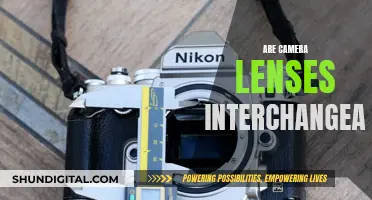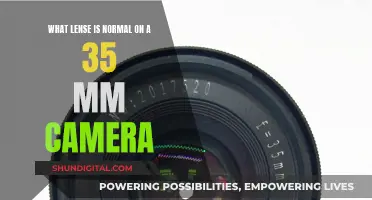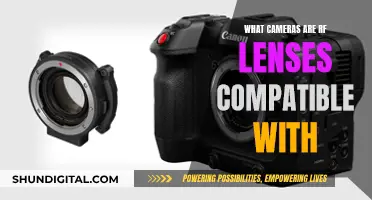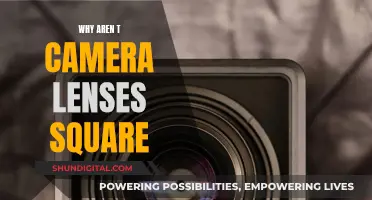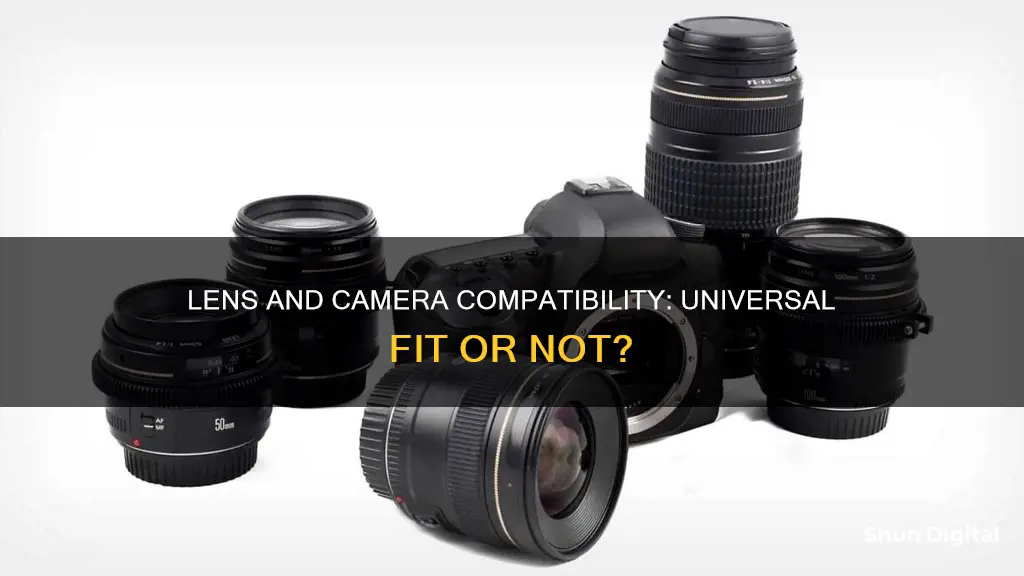
The compatibility of a lens with a camera depends on several factors, including the camera brand, the lens mount, and the sensor size. While some lenses are designed to be interchangeable, allowing photographers to use different lenses for various purposes, not all lenses fit all cameras. Each major camera company (with a few exceptions) uses its own proprietary lens mount, which means that a lens from one brand may not work with a camera body from another brand. For example, Canon lenses are designed to work with Canon cameras and not with Nikon or Sony cameras. Additionally, older lenses may not be compatible with newer camera models, as companies have changed the way lenses and cameras fit together over time. It is important to check the compatibility between the lens and the camera to avoid damage and ensure optimal performance.
| Characteristics | Values |
|---|---|
| Lens compatibility with camera | Depends on the camera brand and type |
| Canon EF lens compatibility | Compatible with any Canon digital SLR made after 1987 |
| Canon FD lens compatibility | Not compatible with Canon EF cameras or any digital cameras |
| Canon EF-M lens compatibility | Compatible with EOS M-series (APS-C mirrorless) cameras |
| Canon RF lens compatibility | Compatible with EOS R-series cameras |
| Nikon F mount lens compatibility | Compatible with most Nikon cameras, including DSLRs |
| Nikon Z mount lens compatibility | Compatible with Nikon mirrorless cameras |
| Sony A-mount lens compatibility | Compatible with Sony DSLRs and mirrorless cameras with an adapter |
| Sony E-mount lens compatibility | Compatible with Sony APS-C mirrorless cameras |
| Micro Four-Thirds lens compatibility | Compatible with Panasonic, Olympus, and other Micro Four-Thirds format cameras |
| Third-party lens compatibility | Depends on the lens mount and sensor size |
What You'll Learn
- Canon EF lenses made after 1987 fit all Canon digital SLRs
- Canon FD mount lenses made before 1987 won't fit any digital cameras
- Nikon has used the same F mount for nearly 60 years, so most lenses will fit
- Sony's a7 MkII is great for using old lenses
- Micro Four Thirds lenses are interchangeable between Panasonic and Olympus cameras

Canon EF lenses made after 1987 fit all Canon digital SLRs
The EF lens mount is the standard lens mount for Canon's EOS family of SLR film and digital cameras. Canon introduced the EF mount in 1987, and it has since become one of the most popular lens mounts in the world, with around 140 million EF lenses produced between 1987 and 2019.
The EF in Canon EF stands for "Electro-Focus". EF lenses feature automatic focusing, facilitated by a dedicated electric motor built into the lens. This was a significant innovation when the EF series was introduced, as it allowed for autofocusing lenses without the need for mechanical levers in the mount mechanism. Instead, the EF mount features electrical contacts that supply power and instructions to the lens motor.
Canon EF lenses are designed to fit all Canon EOS cameras, both film and digital. This includes all Canon digital SLRs, as well as Canon's mirrorless cameras when used with an adapter. The large diameter and short flange focal distance of the EF mount also allow for mechanical adaptation to many types of non-EF lenses, including those with Nikon F, Olympus OM, Leica R, and universal M42 lens mounts.
It's important to note that while EF lenses are compatible with newer Canon bodies, the reverse is not true. Lenses for the earlier Canon FD lens mount, for example, are not usable on EF mount cameras without adapters that include optical elements.
In addition to Canon's own EF lenses, compatible third-party lenses with the EF lens mount are manufactured by various companies, including Yongnuo, Samyang, Schneider, Sigma, Tamron, Tokina, Cosina, and Carl Zeiss. These third-party lenses are designed to work with Canon EF mount cameras, but it's important to note that they are not officially supported by Canon, and compatibility issues may arise, especially when using older third-party lenses with newer camera bodies.
Cleaning Camera Lenses: A Step-by-Step Guide
You may want to see also

Canon FD mount lenses made before 1987 won't fit any digital cameras
The compatibility of a lens with a camera depends on the lens mount. The lens mount is the junction where the camera and the lens meet and every major camera company uses its own proprietary mount. Canon FD mount lenses, for example, were designed to be used with 35mm single-lens reflex camera bodies. Introduced in 1971, the FD mount served as Canon's SLR interchangeable lens mounting system until the introduction of the Canon EOS series in 1987, which uses the newer EF lens mount.
Therefore, Canon FD mount lenses made before 1987 will not fit any digital cameras that use the EF lens mount, including Canon's EOS series. It is worth noting that even lenses from the same company that made your camera may not work with your camera body, as companies often update their lens mounts over time.
While it is possible to adapt some lenses to fit other camera bodies, this may require the use of an adapter and can result in reduced image quality. Additionally, features such as autofocus and auto-exposure may not be supported when using an adapted lens.
In summary, while there are ways to adapt lenses to fit different camera bodies, it is important to ensure compatibility between the lens and camera to avoid any issues with functionality and image quality.
Universal Camera Lenses: A Myth or Reality?
You may want to see also

Nikon has used the same F mount for nearly 60 years, so most lenses will fit
The compatibility of lenses with cameras is a complex issue. The junction where the camera meets the lens is called the mount, and every major company uses its own proprietary mount. This means that, generally, lenses are not interchangeable between brands. For example, Canon lenses are designed to work with Canon cameras and not Nikon or Sony cameras. While third-party mounting adapters are available, they do not always guarantee the compatibility of features.
Nikon has used the same F-mount since the late 1950s, specifically since the introduction of the Nikon F camera in 1959. The F-mount is a type of interchangeable lens mount developed by Nikon for its 35mm format single-lens reflex cameras. It features a three-lug bayonet mount with a 44mm throat and a flange-to-focal plane distance of 46.5mm. The F-mount is one of only two SLR lens mounts that have not been abandoned by their associated manufacturer upon the introduction of autofocus. Instead, it has been extended to meet new requirements related to metering, autofocus, and aperture control.
The F-mount's long history means that Nikon has had over 60 years to develop and expand its system of compatible lenses. This is a significant advantage for photographers who use Nikon cameras, as it means they can choose from a large selection of lenses, including AF Nikkor, AF-S (Silent Wave Motor), and PC-E perspective-control Nikkor lenses. The F-mount is also used by other brands, including Fujifilm, Sinar, JVC, Kenko, and Horseman, further expanding the range of compatible lenses.
The F-mount also offers a significant degree of both backward and forward compatibility. Many current autofocus F-mount lenses can be used on the original Nikon F, and even some of the earliest manual-focus F-mount lenses from the 1960s and early 1970s can still be used on modern Nikon camera bodies with some modifications. However, incompatibilities do exist, and F-mount users should consult product documentation to avoid problems. For example, many electronic camera bodies cannot meter without a CPU-enabled lens, and the aperture of G-designated lenses cannot be controlled without an electronic camera body.
Nikon's commitment to maintaining the F-mount over the decades has resulted in an extensive ecosystem of compatible lenses, offering photographers a wide range of options to suit their creative needs.
The High Cost of Camera Lenses: Why So Expensive?
You may want to see also

Sony's a7 MkII is great for using old lenses
Sony's a7 MkII is a great camera for using old lenses. The camera's E-mount is supremely adaptable due to the short flange-back distance, meaning that lenses for a great many systems can be attached to the a7 MkII without huge cost via a range of third-party mount adapters.
The a7 MkII is a highly adaptable camera that allows you to buy your lenses once and use them on your current and future cameras with the aid of a simple adapter. Adapters are available for virtually any lens mount, but finding an affordable adapter that also performs well can prove to be difficult.
The a7 MkII's full-frame sensor is less demanding on the lenses, you can get decent wide-angle lenses, more depth-of-field control and the sensor offers better image quality.
The a7 MkII features an integrated image stabiliser which works with manual lenses. You need to tell the camera your focal length though, which costs 2 or 3 seconds.
The a7 MkII is a great choice if you want to explore manual lenses.
Protect Your Camera Lens: Storage Tips for Photographers
You may want to see also

Micro Four Thirds lenses are interchangeable between Panasonic and Olympus cameras
In general, camera lenses are not universal and are often designed to be used with specific camera models or brands. Each major camera company (with a few exceptions) uses its own proprietary lens mount, meaning that a lens from one company may not fit a camera body from another. For example, Canon lenses are designed to work with Canon cameras, and not Nikon or Sony cameras.
However, Micro Four Thirds lenses are interchangeable between Panasonic and Olympus cameras. This is because Panasonic, Olympus, and other companies like Black Magic have embraced the standardised Micro Four Thirds format. These lenses cover sensors that are half the size of a full-frame chip. So, if you look through a 50mm lens on a Micro Four Thirds camera, you’ll see what you’d expect from a 100mm lens on a full-frame camera.
While Micro Four Thirds lenses are interchangeable between Panasonic and Olympus cameras, there are some limitations and caveats to this compatibility. Firstly, it is important to ensure that your camera body firmware and lens firmware are updated to the latest available version. Additionally, there may be differences in image stabilisation between Panasonic and Olympus lenses and camera bodies. Olympus uses in-body image stabilisation (IBIS), while older Panasonic bodies placed image stabilisation in the lens. This means that Olympus lenses on older Panasonic bodies may not have any image stabilisation, and vice versa.
Another consideration is lens correction. In-camera lens correction may not work for all combinations of Panasonic and Olympus lenses and camera bodies. However, this is usually a low-impact issue, as post-processing software can be used to perform lens corrections.
In summary, while Micro Four Thirds lenses are interchangeable between Panasonic and Olympus cameras, there may be some limitations and workarounds required to ensure full functionality and compatibility. It is always a good idea to consult official compatibility information and user forums before purchasing or using a lens with a different camera body.
Frequently asked questions
No, not all lenses fit all cameras. The compatibility of a lens with a camera depends on the camera brand and model, and the lens mount.
The lens mount is the junction where the camera and the lens meet. Each major camera company uses its own proprietary mount, so a lens made for a specific camera brand will only fit that brand, or a third-party lens made for that specific mount.
It depends. In some cases, you can use an adapter to fit a lens from one brand on a camera from another brand. However, this is not always possible, and even with an adapter, some features may not work properly.
You can check the lens mount on your camera to see if there are any indicators of compatibility. For example, on Canon cameras, a red circle on the lens mount indicates compatibility with EF lenses. You can also refer to the camera and lens manuals, or check online resources for specific lens and camera combinations.



